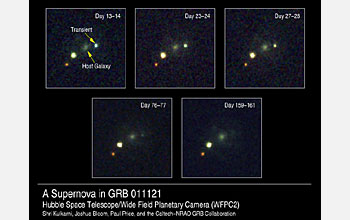Multimedia Gallery
This series of Hubble Space Telescope images shows the likely home of the gamma-ray burster.
On Nov. 21, 2001, a burst of gamma rays was detected. The series of Hubble Space Telescope images show the fading transient lies to the right of a fuzzy, distant galaxy, likely home to the gamma-ray burster. The transient did not not simply fade away though. Instead, it brightened up again days after the burst. This is evidence that at least some gamma-ray bursts are produced when a star dies.
Credit: S. Kulkarni, J. Bloom, P. Price, Caltech - NRAO GRB Collaboration
Images credited to the National Science Foundation, a federal agency, are in the public domain. The images were created by employees of the United States Government as part of their official duties or prepared by contractors as "works for hire" for NSF. You may freely use NSF-credited images and, at your discretion, credit NSF with a "Courtesy: National Science Foundation" notation.
Additional information about general usage can be found in Conditions.
Also Available:
Download the high-resolution JPG version of the image. (59 KB)
Use your mouse to right-click (Mac users may need to Ctrl-click) the link above and choose the option that will save the file or target to your computer.
Related story: Search Is on for Hot Young Stars



